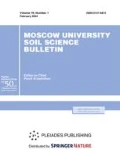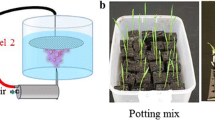Abstract
In places of hydrogen emanation, prolonged exposure to significant concentrations of hydrogen under natural conditions led to the inhibition or death of agricultural plants. Under the conditions of model experiments, it was shown that plants in a short-term current of hydrogen experience stress, which negatively affects their physiological functions. Different types of plants reacted differently both to the effect of molecular hydrogen and to the removal of its load. In experiments with watercress, plants did not recover after the removal of the hydrogen load but died after a triple exposure. Wheat was less sensitive; the plants were only stably (30%) depressed during the whole observation period.



Similar content being viewed by others
REFERENCES
Zavarzin, G.A., Bakterii i sostav atmosfery (Bactria and Atmosphere Composition), Moscow, 1984.
Kanivets, V.I., Interaction between hydrogen, methane and hydrogen sulphide and mineral part of soil, Pochvovedenie, 1970, no. 5.
Larin, N.V., Larin, V.N., and Gorbatikov, A.V., Ring structures formed by deep hydrogen flows, Materialy Vserossiiskoi konferentsii s mezhdunarodnym uchastiem, posvyashchennoi 100-letiyu so dnya rozhdeniya akademika P.N. Kropotkina “Degazatsiya Zemli: geotektonika, geodinamika, geoflyuidy; neft’ i gaz; uglevodorody i zhizn’” (Proc. All-Russian Conf. with International Participation Dedicated to the 100th Anniversary of P.N. Kropotkin Academician “Earth Degassing: Geotectonics, Geodynamics, Geofluids; Oil and Gas; Hydrocarbons and Life”), Moscow, 2010.
Peive, Ya.V., Biokhimiya pochv (Soils Biochemistry), Moscow, 1961.
Piskarev, I.M., Ushkanov, V.A., Aristova, N.A., et al., Establishment of the redox potential of water saturated with hydrogen, Biophysics (Moscow), 2010, vol. 55, no. 1, pp. 13–17.
Sukhanova, N.I. and Kiryushin, A.V., Effect of deep hydrogen flow onto soils chemical properties and humic state, in Sistema Planeta Zemlya (Earth Planet System), Moscow, 2014.
Syvorotkin, V.L., Glubinnaya degazatsiya zemli i global’nye katastrofy (Deep Degassing of the Earth and Global Catastrophes), Moscow, 2002.
Syvorotkin, V.L., Ozone anomalies over Voronezh are the indicators of deep degassing, Materialy litologicheskogo soveshchaniya. “Litologiya i poleznye iskopaemye Tsentral’noi Rossii” (Proc. Lithologic Meeting “Lithology and Natural Resources of Central Russia”), Voronezh, 2000.
Timchenko, E.V., Selezneva, E.A., Tregub, N.V., et al., Hydrogen effect onto optical properties of plants: experimental researches, Izv. Samar. Nauch. Tsentra, Russ. Akad. Nauk, 2014, vol. 16, no. 1.
Shestopalov, V.M. and Makarenko, A.N., Surface and subsurface manifestations of anomalous degassing, Geol. Zh., 2013, no. 3.
Dixon, B.J., Tang, J., and Zhang, J.H., The evolution of molecular hydrogen: a noteworthy potential therapy with clinical significance, Med. Gas. Res., 2013, vol. 3, no. 1.
Dole, M., Wilson, F.R., and Fife, W.P., Hyperbaric hydrogen therapy: a possible treatment for cancer, Science, 1975, vol. 190, no. 4210, pp. 152–154.
Hoehler, T.M., Albert, D.B., Alperin, M.J., et al., Comparative ecology of H2 cycling in sedimentary and phototropic ecosystems, Int. J. Gen. Mol. Microbiol., 2002, vol. 81, nos. 1–4, pp. 575–585.
Iton, T., Fujita, Y., Ito, M., et al., Molecular hydrogen suppresses FcepsilonRI-mediated signal transduction and prevents degranulation of mast cells, Biochem. Biophys. Res. Commun., 2009, vol. 389, no. 4, pp. 651–656.
Kamimura, N., Nishimaki, K., Ohsawa, I., et al., Molecular hydrogen improves obesity and diabetes by inducing hepatic FGF21 and stimulating. Energy metabolism in db/db mice, Obesity, 2011, no. 7.
Lee, M.Y., Kim, Y.K., Ryoo, K.K., et al., Electrolyzed-reduced water protects against oxidative damage to DNA, RNA, and protein, Appl. Biochem. Biotechnol., 2006, vol. 135, no. 2, pp. 133–144.
Larin, N., Zgonnik, V., Rodina, S., et al., Natural molecular hydrogen seepage associated with surfacial, rounded depressions on the European Craton in Russia, Nat.Res. Res., 2014, vol. 24, no. 3, pp. 369–383.
Lubitz, W., Ogata, H., Rudiger, O., et al., Hydrogenases, Chem. Rev., 2014, vol. 114, no. 8, pp. 4081–4148.
Nakai, Y., Sato, B., Ushiama, S., et al., Hepatic oxidoreduction-related genes are upregulated by administration of hydrogen-saturated drinking water, Biosci., Biotechnol., Biochem., 2011, vol. 75, no. 4, pp. 774–776.
Polyanskaya, L.M., Sukhanova, N.I., and Chakmazyan, K.V., Specific features of the structure of microbial biomass in soils of annular mesodepression in Lipetsk end Volgograd oblasts, EurasianSoil Sci., 2014, vol. 47, no. 9, pp. 904–909.
Sun, H., Chen, L., Zhou, W., et al., The protective role of hydrogen-rich saline in experimental liver injury in mice, J. Hepatol., 2011, vol. 54, no. 3.
Vignais, P.M. and Billoud, B., Occurrence, classification, and biological function of hydrogenesis: an overview, Chem. Rev., 2007, vol. 107, no. 10, pp. 4206–4272.
Zhang, J.Y., Liu, C., Zhou, L., et al., A review of hydrogen as a new medical therapy, Hepato-Gastroenterology, 2012, vol. 59, no. 116, pp. 1026–1032.
Author information
Authors and Affiliations
Corresponding authors
Ethics declarations
Conflict of interests. The authors declare that they have no conflicts of interest.
Statement on the welfare of animals. This article does not contain any studies involving animals performed by any of the authors.
Additional information
Translated by Mikhail Bibov
About this article
Cite this article
Sukhanova, N.I., Lysak, L.V. & Kiryushin, A.V. Influence of Hydrogen Fluid on Plants in Natural Conditions and a Model Experiment. Moscow Univ. Soil Sci. Bull. 74, 208–213 (2019). https://doi.org/10.3103/S0147687419050053
Received:
Revised:
Accepted:
Published:
Issue Date:
DOI: https://doi.org/10.3103/S0147687419050053




